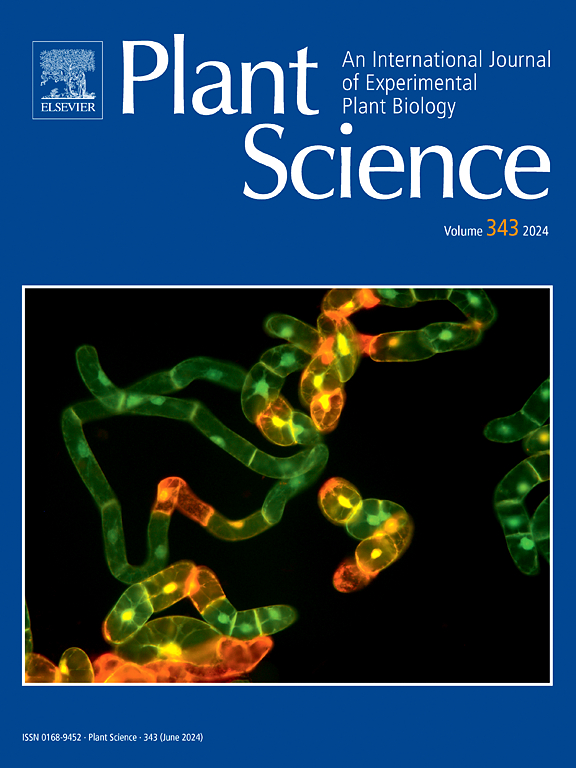ERD15 promotes peach and tomato ripening by activating polyamine catabolism
IF 4.2
2区 生物学
Q2 BIOCHEMISTRY & MOLECULAR BIOLOGY
引用次数: 0
Abstract
Polyamine oxidase (PAO) is a key enzyme in polyamine (PA) catabolism and plays a vital role during fruit ripening. However, regulatory mechanisms that control PAO expression during maturation remain unclear. This study identifies the transcription factor PpeERD15 through yeast one-hybrid (Y1H) screening with the PpePAO1 promoter. ERD15 (early response to dehydration 15), a member of the early response to dehydration protein family, is known for its role in abiotic stress responses, but its function in fruit ripening remains largely unexplored. Subcellular localization analysis demonstrated that PpeERD15 was localized in both the nucleus and cytoplasm. Y1H and LUC assays confirmed that PpeERD15 directly binds the PpePAO1 promoter. Transient silencing of PpEDR15 in peach fruit downregulated PpePAO1 expression, promoted PA accumulation, inhibited ethylene production, increased fruit firmness, and delayed fruit ripening. Conversely, overexpression of PpeEDR15 upregulated PpePAO1, decreased PA content, promoted ethylene production, reduced fruit firmness, and accelerated fruit ripening. The role of homologous gene of ERD15 was also validated in tomato. This study discovered that PpeEDR15 regulates fruit ripening by promoting PA catabolism via PpePAO1 expression.
ERD15通过激活多胺分解代谢促进桃子和番茄成熟
多胺氧化酶(Polyamine oxidase, PAO)是多胺分解代谢的关键酶,在果实成熟过程中起着至关重要的作用。然而,在成熟过程中控制PAO表达的调控机制尚不清楚。本研究通过酵母单杂交(Y1H)筛选PpePAO1启动子,鉴定了转录因子PpeERD15。ERD15(早期脱水反应)是早期脱水反应蛋白家族的一员,以其在非生物胁迫反应中的作用而闻名,但其在果实成熟中的功能仍未被充分研究。亚细胞定位分析表明PpeERD15定位于细胞核和细胞质中。Y1H和LUC实验证实PpeERD15直接结合PpePAO1启动子。桃果实中PpEDR15的短暂沉默降低了PpePAO1的表达,促进了PA的积累,抑制了乙烯的产生,增加了果实的硬度,延迟了果实的成熟。相反,过表达pepedr15可上调PpePAO1,降低PA含量,促进乙烯生成,降低果实硬度,加速果实成熟。ERD15同源基因在番茄中的作用也得到了验证。本研究发现,pepedr15通过表达pepepao1促进PA分解代谢,从而调控果实成熟。
本文章由计算机程序翻译,如有差异,请以英文原文为准。
求助全文
约1分钟内获得全文
求助全文
来源期刊

Plant Science
生物-生化与分子生物学
CiteScore
9.10
自引率
1.90%
发文量
322
审稿时长
33 days
期刊介绍:
Plant Science will publish in the minimum of time, research manuscripts as well as commissioned reviews and commentaries recommended by its referees in all areas of experimental plant biology with emphasis in the broad areas of genomics, proteomics, biochemistry (including enzymology), physiology, cell biology, development, genetics, functional plant breeding, systems biology and the interaction of plants with the environment.
Manuscripts for full consideration should be written concisely and essentially as a final report. The main criterion for publication is that the manuscript must contain original and significant insights that lead to a better understanding of fundamental plant biology. Papers centering on plant cell culture should be of interest to a wide audience and methods employed result in a substantial improvement over existing established techniques and approaches. Methods papers are welcome only when the technique(s) described is novel or provides a major advancement of established protocols.
 求助内容:
求助内容: 应助结果提醒方式:
应助结果提醒方式:


